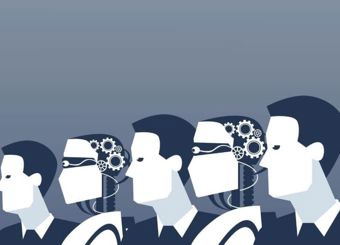The history of accounting - from record-keeping to artificial intelligence
The history of accounting is fascinating and colorful. While today’s companies often rely on modern processes, the earliest records of business and financial transactions began on clay tablets. Today, automated technology is used in many accounts payable departments for data capture, validation, matching and more. Explore the compelling evolution of accounting and learn how the numbers game has become what it is now.
Accounting in ancient history
Accounting is a system of recording and summarizing financial and business transactions. Record-keeping, accounting, and accounting tools have been used for as long as civilizations have engaged in trade. Many historians hypothesize that one reason writing systems were developed was to record trade transactions. Some of the earliest writings discovered by archaeologists are accounts of tax records on clay tablets. These first examples of accounting from Mesopotamia and Egypt date back to between 3300 and 2000 BCE.
In the 13th century, medieval Europe moved toward a money economy. Merchants relied on bookkeeping to oversee the multiple simultaneous transactions financed by bank loans. As industry moved forward, it was clear that accounting procedures needed to be refined for higher accuracy and efficiency.
The father of accounting
In 1458, Benedetto Contrugli invented the double-entry accounting system - broadly defined as any bookkeeping system that involves a debit and/or credit entry for transactions. The double-entry system revolutionized accounting.
Luca Bartolomeo de Pacioli, an Italian mathematician and Franciscan monk, invented a system of record-keeping that used a memorandum, ledger, and journal. He also wrote many books on accounting. Thus, Paciolo became known as the father of accounting and bookkeeping. In 1494, he wrote Summa de Arithmetica, Geometria, Proportioni et Proportionalita ("The Collected Knowledge of Arithmetic, Geometry, Proportion, and Proportionality"), which included a 27-page treatise on bookkeeping.
Centuries later, in 1854, the first professional organizations for accountants - the Edinburgh Society of Accountants and the Glasgow Institute of Accountants and Actuaries - were established in Scotland. Members of these early organizations could refer to themselves as “chartered accountants". Then, in 1887, the American Institute of Certified Public Accountants was established.
The early systems and electronic data interchange
Always finding ways to improve accounting and AP processes, inventors started to create machines for mathematical calculations. For example, in the 1880s, American William Burroughs invented the adding machine. Early adding machines did not have the critical features of a computer, such as internal memory. However, they enabled accountants to carry out arithmetic with higher accuracy and efficiency.
By the end of the century, technology continued to progress. Herman Hollerith developed a punch-card machine to speed up data handling for the U.S. Census. These innovative tabulating machines recorded data by punching a pattern of holes into cards. The machine could also read these patterns to call up pertinent information. Hollerith took the punch-card concept into private industry when he founded IBM. Businesses were using punch-card machines for accounting by 1907; an IBM tabulator could process 100 cards a minute by 1928.
Accounting took a giant step toward the future as we know it in 1955, when a company bought a computer for the first time purely for accounting. After World War II, General Electric purchased the UNIVAC (the UNIVersal Automatic Computer) to run payroll in its factories. Developed by John Mauchly and J. Presper Eckert, the UNIVAC stored data on magnetic tape instead of punch cards. The UNIVAC took 40 hours to complete the payroll process.
The ongoing evolution of accounting automation tools
AP processes were streamlined in the 1960s when the U.S. transportation industry developed EDI to standardize transactions between vendors and customers. By 1982, automotive industry customers, including Ford and General Motors, started to mandate EDI for their suppliers. Today, all major industries employ EDI, making it a significant milestone in the history of accounting. Sets of EDI standards, such as EDIFACT (the primary standard in Europe) and X12 (the primary standard in the United States), govern the structure and content of documents.
In 1978, the accounting world saw the birth of Visicalc. It was the first spreadsheet software that enabled financial modeling on the computer. During the same year, Peachtree Software introduced an accounting software package for the early personal computer. As a result, companies could computerize their accounting at a fraction of the cost of purchasing a mainframe. Then, in 1998, Quickbooks was launched. It soon dominated the market for day-to-day bookkeeping. Today, over 4.5 million companies use Quickbooks, making it the most popular accounting program in the U.S.
Optical character recognition (OCR) and intelligent data capture (IDC)
Another shift in the history of accounting occurred in early 2000. The financial world experienced the entry of Advanced Data Capture: Optical Character Recognition (OCR) and Intelligent Data Capture (IDC) technology, which enables the automation of the accounts payable process. Instead of manually entering the information, critical bits of data – such as the PO number, amount or date – are digitally captured and populated in various index fields. Pre-set templates for commonly structured documents enable information to be automatically entered into the system. Customized business rules can be applied to add accounting automation tools to the process from start to finish.
Today companies are increasing their AP efficiency with benchmarks based on robust technology that identifies and tracks complex factors that impact the accounts payable workflow. Powerful performance dashboards and benchmarking capabilities improve the AP processes continuously. Analytics tools can monitor key performance indicators (KPIs) touchlessly compare automation levels against real-world benchmarks, leverage best-practice workflows, and consult experts for ongoing improvements.
Artificial intelligence and the future of accounting
A 2018 study by Atherton Research predicted that accounting and payroll, tax, banking, and audits, would be completely automated using AI-based technologies by 2020. And indeed, in the three years since the release of the study, AI has played an increasingly important role in the accounting industry, bringing with it both opportunities and challenges.
Rest assured that artificial intelligence will not eliminate accountants, however. Stephanie Weil, CEO of Accounteam, a Silicon Valley-based accounting firm, explained, “Having machines to do all these tedious and repetitive tasks could sound scary for many accountants because they are also very time-consuming and thus very lucrative… [but] if the AI system is well-configured, it can eliminate accounting errors that are generally hard to find and thereby reduce our liability and allows us to move to a more advisory role.”
These advancements in accounting technology, including Machine Learning, are also helping identify patterns in the processes that can be addressed with further automation - such as suppliers with a high level of exceptions or technology features not currently in use - that, if addressed, will help lessen the manual, arduous tasks facing accountants so that they can focus their time on more strategic tasks.
The history of accounting is in a continuous state of evolution, improving accuracy, achieving optimum efficiency, and accommodating the growth of business and commerce around the world. AP processes are simplified with accounting automation tools, giving the AP team more time to devote to the analytical and administrative functions that benefit the C-suite and the company at large. By studying the past, accounting professionals can recognize and address the ongoing changes that occur within this essential industry, thereby boosting its value.





